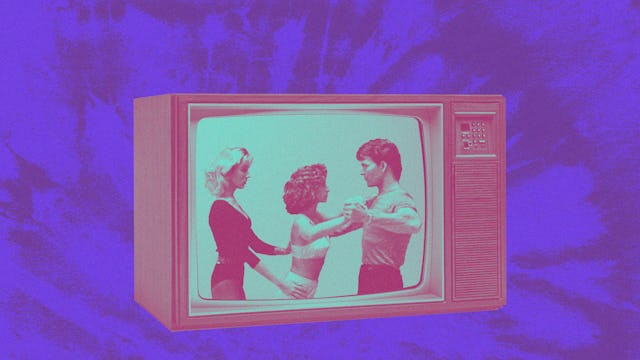35 years later, the movie’s storyline feels like a warning of what’s to come rather than a reminder of what we left behind.


The back alley abortion in ‘Dirty Dancing’ hits different right now
The opening voiceover of Dirty Dancing sets the scene as a simpler, more peaceful time — a last gasp of innocence for both Frances “Baby” Houseman and for the country. “That was the summer of 1963, when everybody called me ‘Baby’ and it didn’t occur to me to mind,” we hear Baby (Jennifer Grey) say, over a scene of the Houseman family on the open road, heading to New York’s Catskills for the summer. “That was before President Kennedy was shot, before the Beatles came, when I couldn’t wait to join the Peace Corps, and I thought I’d never find a guy as great as my dad.” And crucially, the movie, which debuted in 1987, was also set 10 years before Roe v. Wade made abortion legal nationwide.
While Dirty Dancing is clearly both a coming-of-age story and a love story, the movie doesn’t fall into the trap of connecting Baby’s growth with the loss of her virginity. Instead, as screenwriter Eleanor Bergstein explained to Cosmopolitan back in 2017, the entire plot hinges on one thing: abortion. After resort dancer Penny gets pregnant, Baby finds herself tasked with stepping in while the pro takes time off to get an (at the time, illegal) abortion.
That abortion is the reason Baby spends time with Penny’s dance partner, Johnny (Patrick Swayze), eventually falling in love with him. It’s the reason she lies to her father for the first time ever, when she asks him for money to help a friend in “trouble” while refusing to offer more details. And, after the illegal abortion goes horribly awry, it’s the reason Baby comes clean with her father — a doctor — and faces his disappointment, in favor of asking him to help save Penny’s life. Yes, we love the dancing, and the chemistry between Grey and Swayze is electric, but ultimately, Dirty Dancing is a deeply political movie about abortion, class struggle, and feminist identity. And watching it 35 years after its release and 59 years after its time period, it’s abundantly clear that we as a society have moved in the wrong direction.
Penny’s abortion in Dirty Dancing would have taken place right before the abortion rights movement reached a fever pitch in the U.S. In 1963, abortion was illegal nationwide, but the movement for reproductive rights was beginning to gain steam. In 1955, after about 50 years of bans — and an associated rise in dangerous, illegal abortions — Planned Parenthood held its first ever conference on abortion, where the doctors in attendance called for reform. By 1965, illegal abortions accounted for 17% of all deaths related to pregnancy and childbirth, with low-income women being disproportionately impacted, according to the Guttmacher Institute.
But between 1967 and 1973 — just a few years after Dirty Dancing takes place — 17 states repealed their abortion bans or reformed their laws to allow some access to abortion. The number of deaths from the procedures began plummeting. After Roe v. Wade legalized abortion nationwide in 1973, that number dropped even lower, hovering right around zero in the years since.
Ultimately, Dirty Dancing is a deeply political movie about abortion, class struggle, and feminist identity.
This all means watching Dirty Dancing in 2022 is enough to make your head spin — if not nearly explode in anger. We’re living in a time when abortion rights are being stripped away by the federal government, looking at a time when abortion was banned by the federal government, through the lens of a movie written when abortion bans themselves were banned by the federal government. It’s a pretty sad circle.
That’s not to say abortion wasn’t a hot button topic when Dirty Dancing premiered. Though Roe v. Wade was (seemingly) settled law at the time, Republican politicians were running (and winning) on anti-abortion platforms — and the inclusion of an illegal abortion plotline in a feature film was certainly controversial. Bergstein even told Vice in 2017 that the movie’s national sponsor pushed the studio to cut abortion from the film, but Bergstein had baked it into the plot so thoroughly that it simply wasn’t possible. Not only did the screenwriter ensure Penny’s abortion would remain a crucial plot point, but she also deliberately painted a picture of the dangers associated with illegal abortions. “I made it very clear that we would leave in what is, for me, very purple language: references to dirty knives, a folding table, hearing Penny screaming in the hallway,” she told Vice. “I had a doctor on set to make sure [the description of illegal abortion] was right.”
She did so knowing that people like me would be watching. “The reason I put that language in there was because I felt that — even with it being a coat hanger abortion — a whole generation of young people, and women especially … wouldn’t understand what [the illegal abortion] was.” In my case, whenever I watched Dirty Dancing up until recently, I breathed a sigh of relief that if I ever needed an abortion, I wouldn’t face Penny’s fate. Abortion was legal; if need be, I could go to a doctor and safely terminate a pregnancy. I wouldn’t have to worry about dying in a back alley or losing my ability to have children if I survived. Unfortunately, that’s no longer the feeling I have when I watch Baby rush to get her father (a doctor) to help Penny, who’s doubled over in pain from a botched procedure. Today, that scene feels like a warning of what’s about to come, rather than a reminder of what we left behind.
People like me may not have identified with Penny’s experience when we originally watched the movie, but it’s about to become much more familiar.
Is 2022 exactly the same as 1963? Of course not. Public perception of abortion has come a long way (most people in the U.S. identify as pro-choice, despite what’s happening among conservative lawmakers), as has medicine. People have better access to and more types of birth control, and there’s also Plan B and medication abortion, neither of which were available in 1963 or 1987. Then again, these things are also under threat by Republicans. Like in-clinic abortion, if Roe is overturned, people living in GOP-controlled states could face even more of an uphill battle trying to access these forms of health care.
I can picture such a scenario with Penny. We saw in the movie that she couldn’t afford even the back-alley abortion she ended up getting, so she certainly would’ve faced financial difficulty to cross state lines for a medication abortion prescription or to find underground access to illegal pills. Once Baby offered to help, they faced an urgent race to get the pills in time. If they managed to get Penny a clinic appointment in another state, she might still face the risk of arrest — especially if there are complications and she needs to go to a hospital — because many Republican lawmakers are aiming to criminalize even traveling for abortions. And of course, every level of risk would’ve been greater if she wasn’t white, as will absolutely be the case in present times, too.
If Republicans gain control of the government in the 2022 and 2024 elections, they have signaled interest in passing a nationwide abortion ban. (Until then, some states will protect access to abortion, even enshrining it in their constitutions.) Revisiting Dirty Dancing feels like a clear call to action to fight such a fate. People like me may not have identified with Penny’s experience when we originally watched the movie, but it’s about to become much more familiar — and it seems Bergstein knew that would eventually be the case. “When I made the movie in 1987, about 1963, I put in the illegal abortion and everyone said, ‘Why? There was Roe v. Wade — what are you doing this for?’” she told Vice. “I said, ‘Well, I don’t know that we will always have Roe v. Wade,’ and I got a lot of pushback on that. Worse than that, there were also very young women then who didn’t remember a time before Roe … so for them I was like Susan B. Anthony, saying ‘Oh, just remember, remember, remember.’”